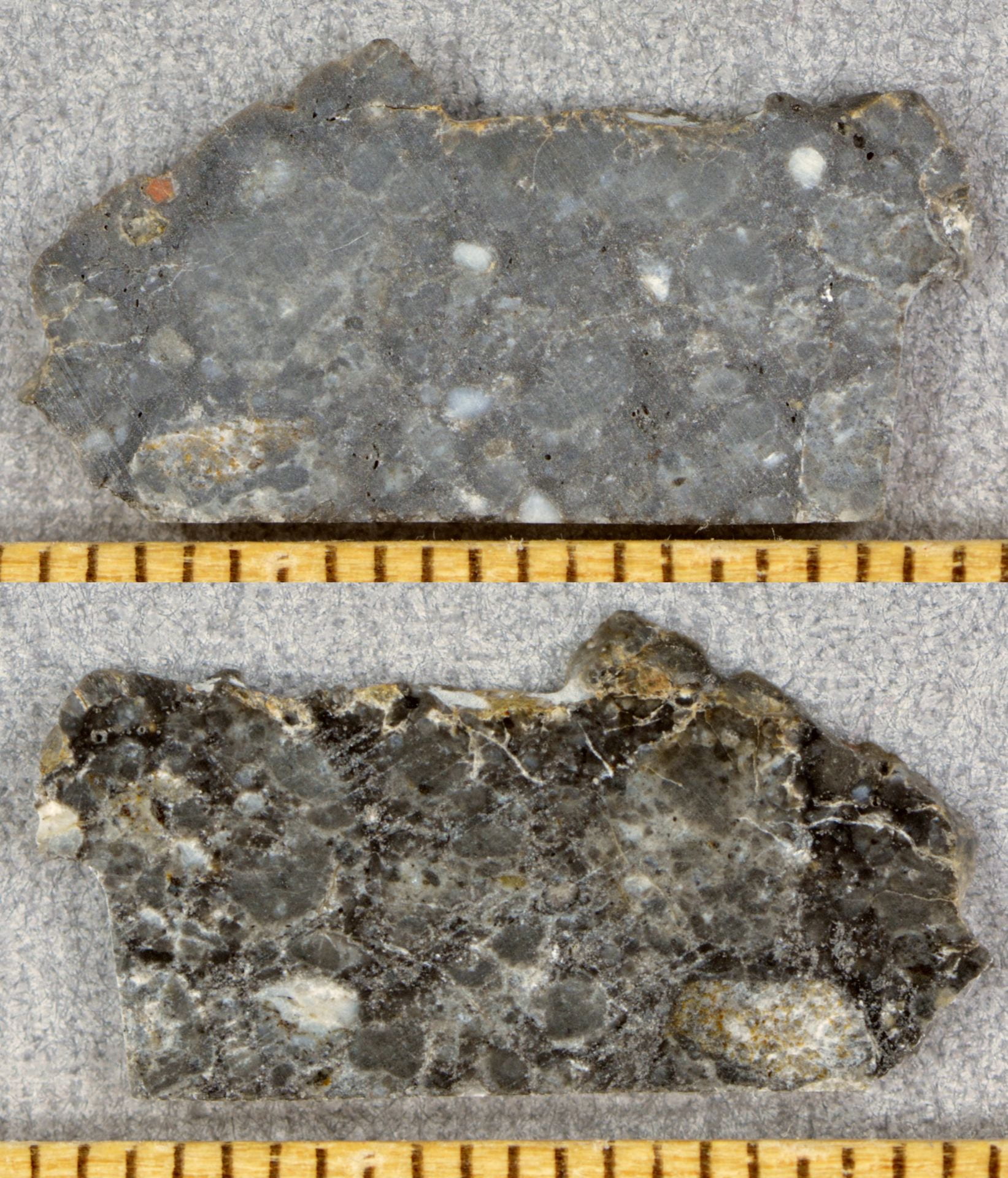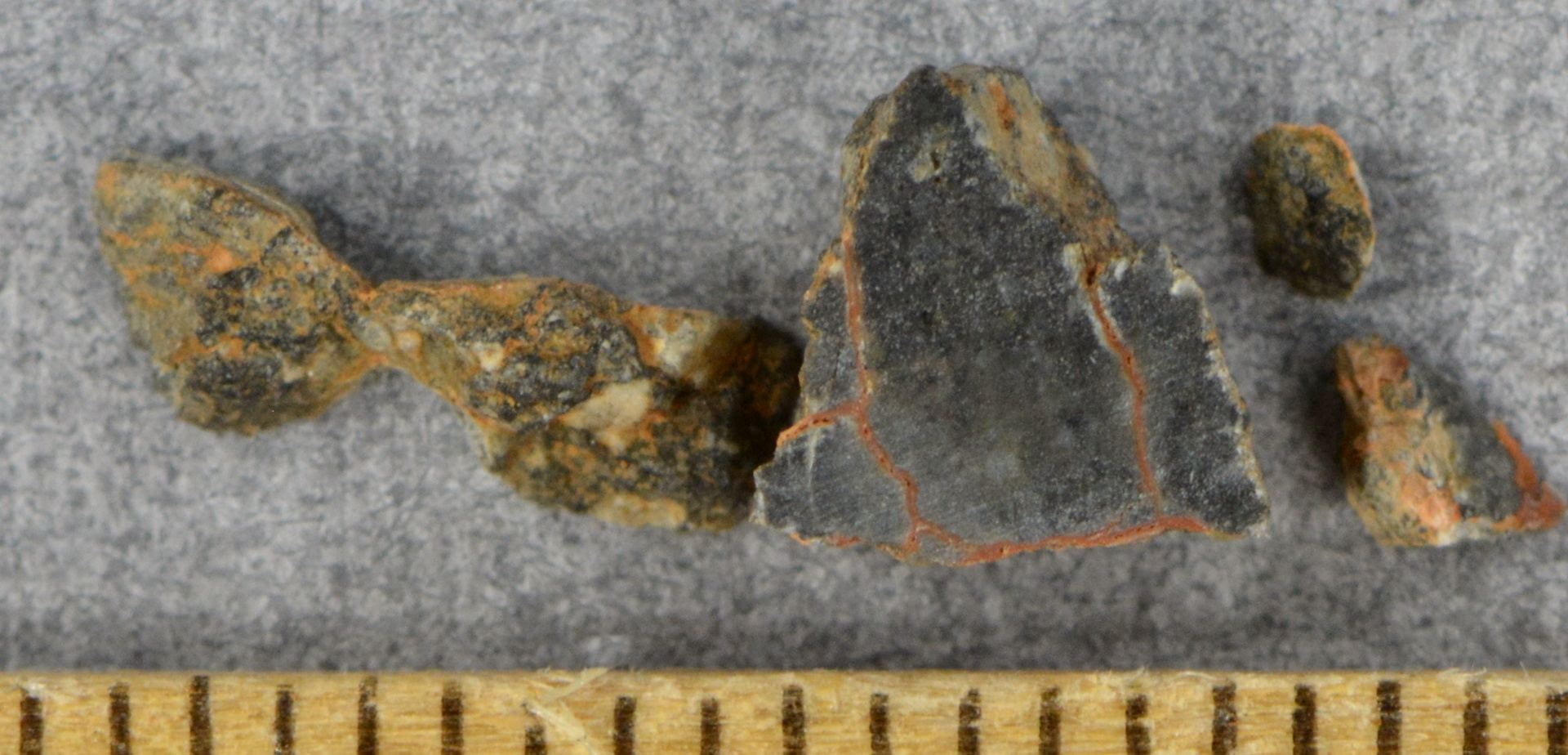Lunar Meteorite: Northwest Africa 10141 clan
The NWA 10415 clan consists of paired stones NWA 10141, 10142?, 10415, & 11111











from The Meteoritical Bulletin, No. 104 Northwest Africa 10141 (NWA 10141)Northwestern Africa Classification: Lunar meteorite (feldspathic breccia) History: Purchased by Matt Morgan and Lee Morgan in Morocco in January 2015. Physical characteristics: Single stone. A saw cut reveals a feldspathic breccia with dark-gray shock melt veins. Petrography: (C. Agee, UNM) This meteorite is mixture of a fine-grained cataclastic domains, large fragmental plagioclase crystals, and shock melt veins; some of the veins have ~100 μm-size vesicles. Accessory troilite, ilmenite, and chromite were observed. Geochemistry: (C. Agee and N. Muttik, UNM) olivine Fa38.8±1.4, Fe/Mn=102±7, n=12; pigeonite Fs34.9±3.6Wo7.2±3.5, Fe/Mn=62±4, n=5; augite Fs25.8±5.3Wo32.1±0.9, Fe/Mn=55±5, n=5; plagioclase An96.7±0.4Ab3.1±0.4Or0.2±0.0, n=6; Shock melt (20 μm defocused electron beam, proxy for bulk meteorite composition): SiO2=44.1±0.4, TiO2=0.18±0.04, Al2O3=31.4±1.0, Cr2O3=0.06±0.02, MgO=3.3±0.7, FeO=3.4±0.6, MnO=0.04±0.02, CaO=17.4±0.5, NiO=0.02±0.02, Na2O=0.33±0.03, K2O=0.05±0.01 (all wt%), Fe/Mn=76±17, Mg#=63±2, MgO+FeO=6.7±1.3 (wt%), n=10. Classification: Lunar (feldspathic breccia) Specimens: 8.1 g including a probe mount on deposit at UNM, MtMorgan and Lee Morgan hold the main mass. |
from The Meteoritical Bulletin, No. 104 Northwest Africa 10142 (NWA 10142)(Northwest Africa) Classification: Lunar meteorite History: Purchased in Mauritania by Mohamed Aid, 2014. Physical characteristics: Single stone. A saw cut reveals a feldspathic breccia with dark-gray shock melt veins. Petrography: (C. Agee, UNM) This meteorite is dominated by feldspathic-rich domains of fine-grained crystals and larger plagioclase fragments. Abundant shock melt veins are present, some with vesicles. Accessory troilite and ilmenite were observed. Geochemistry: (C. Agee and N. Muttik, UNM) olivine Fa21.3±3.6, Fe/Mn=105±5, n=2; pigeonite Fs25.5±7.9Wo12.0±1.6, Fe/Mn=57±6, n=2; augite Fs17.6±4.7Wo43.2±1.5, Fe/Mn=49±15, low Ca pyroxene Fs51.3Wo2.2, Fe/Mn=63, n=1; plagioclase An96.5±0.4Ab3.3±0.4Or0.2±0.0, n=6; Shock melt (20 µm defocused electron beam, proxy for bulk meteorite composition): SiO2=43.6±0.5, TiO2=0.18±0.07, Al2O3=31.8±2.2, Cr2O3=0.06±0.04, MgO=3.3±1.7, FeO=3.0±1.3, MnO=0.04±0.02, CaO=17.3±0.5, wt%), Fe/Mn=88±62, Mg#=64±7, MgO+FeO=6.3±2.9 (wt%), n=23. Classification: Lunar (feldspathic breccia). Specimens: 20.5 g including a probe mount on deposit at UNM, Jarkko Kettunen holds the main mass. |
from The Meteoritical Bulletin, No. 104 Northwest Africa 10415 (NWA 10415)(Northwest Africa) Classification: Lunar meteorite (feldspathic breccia) History: Aras Jonikas purchased three stones from a Moroccan dealer in Guelmim, in August 2015. Physical characteristics: Three identical appearing stones, 144, 15, and 5 g, with eathered exteriors. A saw cut reveals prominent light-colored feldspathic clasts, also numerous dark-gray clasts, and some shock melt veins and vesicles. Petrography: (C. Agee, UNM) This is a fragmental, cataclastic, shock-melted lunar meteorite. Numerous feldspar grains and scattered olivines and pyroxenes are present throughout. There are shock melt domains present with vesicles. Accessory troilite, chromite, and Fe-oxides were observed. Geochemistry: (C. Agee and N. Muttik, UNM) olivine Fa39.1±0.3, Fe/Mn=104±8, n=2; pigeonite Fs43.0±1.8Wo8.9±0.8, Fe/Mn=60±5, n=2; augite Fs33.3±12.7Wo35.0±6.5, Fe/Mn=64±5, n=2 plagioclase An96.8±0.3, n=2; Shock melt (20 μm defocused electron beam, proxy for bulk meteorite composition): SiO2=46.2±1.2, TiO2=0.17±0.13, Al2O3=31.6±4.4, Cr2O3=0.06±0.05, MgO=3.2±2.4, FeO=3.2±2.3, MnO=0.05±0.04, CaO=17.6±1.8, NiO=0.02±0.02, Na2O=0.34±0.03, K2O=0.10±0.04 (all wt%), MgO+FeO=6.5±4.7 (wt%), n=5. Classification: Lunar (feldspathic breccia), high alumina. Specimens: 20.2 g including a probe mount on deposit at UNM, Aras Jonikas holds the main mass. |
from The Meteoritical Bulletin, No. 106 Northwest Africa 11111 (NWA 11111)Morocco Classification: Lunar meteorite (feldspathic breccia) History: Purchased by Ke Zuokai in Dec. 2016 from a Moroccan dealer. Physical characteristics: No fusion crust; covered by weathering products. Petrography: (Li Y., PMO) Fine-grained mineral (plagioclase, low-Ca pyroxene and olivine) clasts and anorthositic rock debris (0.01-0.6 mm) are set in the very fine-grained recrystallized matrix. Compared to those in clasts (Fa27.6-45.6), the recrystallized olivines are more Mg-rich (Fa21.4-32.0). Minor unrecrystallized shock melt veins (~50 μm) are also present, which crosscut the recrystallized matrix. Accessory Fe-Ni metal, troilite, and chromite were observed. Geochemistry: Plagioclase An96.4-99.4Ab0.5-3.5Or0.4; olivine in clast Fa27.6-45.6, Fe/Mn=77.7-111.3; olivine in matrix Fa21.4-32.0, Fe/Mn=70.9-113.5; orthopyroxene Fs22.5-51.7Wo2.0-4.8, Fe/Mn=49.9-80.8; augite Fs12.4-24.0Wo38.2-45.1, Fe/Mn=39.5-51.9; pigeonite Fs22.1-37.0Wo5.6-9.2, Fe/Mn=44.3-65.0. Classification: Lunar feldspathic melt breccia Specimens: 20 g is on deposit at PMO, Ke Zuokai holds the main mass. |
| Randy Says… With 31–32% Al2O3, the NWA 10141 clan is one of the most feldspathic of lunar meteorites. I have not analyzed NWA 10142 but assume that it is a member of the pair group from the appearance of the sawn faces and the description. The NWA 10141 clan is compositionally indistinguishable from NWA 11077, but the textures are very different. |
More InformationMeteoritical Bulletin Database NWA 10141 | 10142 | 10415 | 11111 References Fu X. H., Hsu W. B., Ling Z. C., Cao H., and Chen J. (2018) Petrography and mineralogy of lunar feldspathic breccia Northwest Africa 11111. 49th Lunar and Planetary Science Conference, abstract no. 1666.Fu X. H., Cao H., Chen J., Hou X., Ling Z. C., Xu L., Zou Y. L., Tang C., and Hsu W. B. (2021) Petrology and geochemistry of lunar feldspathic meteorite Northwest Africa 11111: Insights into the lithology of the lunar farside highlands. Meteoritics & Planetary Science. https://doi.org/10.1111/maps.13743 Korotev R. L. and Irving A. J. (2015) Keeping up with the lunar meteorites – 2015. 46th Lunar and Planetary Science Conference, abstract no. 1942. Korotev R. L. and Irving A. J. (2016) Not quite keeping up with the lunar meteorites – 2016. 47th Lunar and Planetary Science Conference, abstract no. 1358. Korotev R. L. and Irving A. J. (2017) Still not keeping up with the lunar meteorites – 2017. 48th Lunar and Planetary Science Conference, abstract no. 1498. Korotev R. L. and Irving A. J. (2021) Lunar meteorites from northern Africa. Meteoritics & Planetary Science, 206–240. Xu X., Hui H., Chen W., Huang S., Neal C. R., and Xu X. (2020) Formation of lunar highlands anorthosites. Earth and Planetary Science Letters 536, 116138. doi.org/10.1016/j.epsl.2020.116138 |